Research on Autonomous Vehicle Technology Innovation Ecosystem in China Based on System Dynamics
Abstract
1. Introduction
2. Literature Review
2.1. Research on Innovation Ecosystems
2.2. Research on Autonomous Driving Technology
2.3. Research on Technological Innovation in Autonomous Vehicle
3. Methodology
3.1. Boundaries and Assumptions of the System Model
3.2. Causality Analysis
3.2.1. Innovation Resource Supply Subsystem
3.2.2. Technological Innovation Diffusion Subsystem
3.2.3. Incentives and Guarantees Subsystem
3.2.4. Systematic Causality Diagram
3.3. Construction of Stock–Flow Diagram
3.4. Data Sources
4. Model Testing and Simulation
4.1. Historical Testing
4.2. Behavioral Pattern Testing
4.3. Simulation
4.4. Sensitivity Analysis
5. Conclusions and Policy Suggestions
5.1. Conclusions
5.2. Policy Suggestions
5.3. Limitations and Future Research
Author Contributions
Funding
Data Availability Statement
Conflicts of Interest
Appendix A
References
- Pan, S.N.; Li, B.W.; Nie, H.G. Comprehensive Evaluation and Restrictive Factors Analysis of Sustainable Development of China’s New Energy Vehicle Industry: Based on the Perspective of Innovation Ecosystem. Sci. Technol. Manag. Res. 2019, 39, 41–47. [Google Scholar]
- Zhang, X.; Xi, X. Review and Prospect of Research on Innovation Ecosystem. J. Zhengzhou Univ. Light Ind. 2017, 18, 37–47. [Google Scholar]
- Moore, J.F. Predators and prey: A new ecology of competition. Harv. Bus. Rev. 1993, 71, 75–86. [Google Scholar]
- Gomes, L.A.d.V.; Facin, A.L.F.; Salerno, M.S. Managing uncertainty propagation in innovation ecosystems. Technol. Forecast. Soc. Change 2021, 171, 120945. [Google Scholar] [CrossRef]
- Ritala, P.; Almpanopoulou, A. In defense of ‘eco’ in innovation ecosystem. Technovation 2017, 60–61, 39–42. [Google Scholar] [CrossRef]
- Nambisan, S.; Baron, R. Entrepreneurship in Innovation Ecosystems: Entrepreneurs’ Self–Regulatory Processes and Their Implications for New Venture Success. Entrep. Theory Pract. 2013, 37, 1071–1097. [Google Scholar] [CrossRef]
- Granstrand, O.; Holgersson, M. Innovation ecosystems: A conceptual review and a new definition. Technovation 2020, 90–91, 102098. [Google Scholar] [CrossRef]
- Du, D.L.; Jian, X.J. Research on the Resilience Enhancement Path of Regional Digital Innovation Ecosystem. Technological Progress and Countermeasures. pp. 1–12. Available online: http://kns.cnki.net/kcms/detail/42.1224.G3.20241216.1354.002.html (accessed on 6 April 2025).
- Zhang, Q.Y.; Wang, H.Q.; Li, X.L.; Yang, Z.J. Research on the Formation Mechanism of Future Industrial Innovation Ecosystem under Government Structure. Research Management. pp. 1–16. Available online: http://kns.cnki.net/kcms/detail/11.1567.G3.20241231.1422.016.html (accessed on 6 April 2025).
- Luo, G.F.; Lin, X.Y. The Evolution and Dynamic Mechanism of Innovation Ecosystem; Academic Exchange: Beverly Hills, CA, USA, 2015; pp. 119–124. [Google Scholar]
- Liu, X.L.; Yang, P.P.; Ding, X.C. Coordination of Central Real Estate Industry Policies and Development of New Energy Vehicle Industry: Based on the Perspective of Innovation Ecosystem. China Soft Sci. 2023, 11, 38–53. [Google Scholar]
- Gkartzonikas, C.; Gkritza, K. What have we learned? A review of stated preference and choice studies on autonomous vehicles. Transp. Res. Part C Emerg. Technol. 2019, 98, 323–337. [Google Scholar] [CrossRef]
- Daniel, J.F.; Kockelman, K. Preparing a nation for autonomous vehicles: Opportunities, barriers and policy recommendations. Transp. Res. Part A Policy Pract. 2015, 77, 167–181. [Google Scholar]
- Parekh, D.; Poddar, N.; Rajpurkar, A.; Chahal, M.; Kumar, N.; Joshi, G.P.; Cho, W. A Review on Autonomous Vehicles: Progress, Methods and Challenges. Electronics 2022, 11, 2162. [Google Scholar] [CrossRef]
- Rezaei, A.; Caulfield, B. Safety of autonomous vehicles: What are the insights from experienced industry professionals? Transp. Res. Part F Traffic Psychol. Behav. 2021, 81, 472–489. [Google Scholar] [CrossRef]
- Hamadneh, J.; Duleba, S.; Duleba, S. Stakeholder viewpoints analysis of the autonomous vehicle industry by using multi-actors multi-criteria analysis. Transp. Policy 2022, 126, 65–84. [Google Scholar] [CrossRef]
- Qin, Y.Y.; Luo, Q.Z.; Xiao, T.F. Capacity modeling for mixed traffic with connected automated vehicles on minor roads at priority intersections. Transp. Plan. Technol. 2024, 1–25. [Google Scholar] [CrossRef]
- He, Z.C.; Li, Y.J.; Bai, M.J.; Pan, W.H. Core firms’ construction of digital-smart innovation ecosystems-the case of Huawei Automobile. Financ. Econ. Theory Pract. 2024, 45, 100–108. [Google Scholar]
- Chen, W. Research on the Coupling Mechanism of Innovation Ecosystem of Intelligent Networked Automobile Industry. Master’s Thesis, Nanjing University of Science and Technology, Nanjing, China, 2021. [Google Scholar]
- Wu, J.L.; Hao, M.X.; Huang, J. Research on the construction of enterprise innovation ecosystem under the environment of “Internet+”—Taking Azalea New Energy Vehicle as an example. Soft Sci. 2021, 35, 70–77. [Google Scholar]
- Ge, L.J. Research on Innovation Ecosystem of Intelligent Networked Automobile Industry. Master’s Thesis, Hunan University, Changsha, China, 2019. [Google Scholar]
- Li, Y.N.; Liang, C.C.; Ye, F.; Zhao, X. Designing government subsidy schemes to promote the electric vehicle industry: A system dynamics model perspective. Transp. Res. Part A Policy Pract. 2023, 167, 103558. [Google Scholar] [CrossRef]
- Zhao, X.G.; Wang, W.; Wu, L. A dynamic analysis of research and development incentive on China’s photovoltaic industry based on system dynamics model. Energy 2021, 233, 121141. [Google Scholar]
- Xi, R. Research on the Influencing Factors and Optimization Path of Technological Innovation in China’s Intelligent Connected Vehicle Industry. Master’s Thesis, Beijing Jiaotong University, Beijing, China, 2021. [Google Scholar]
- Ye, R.K.; Gao, Z.F.; Fang, K.; Liu, K.-L.; Chen, J.-W. Moving from subsidy stimulation to endogenous development: A system dynamics analysis of China’s NEVs in the post-subsidy era. Technol. Forecast. Soc. Change 2021, 168, 120757. [Google Scholar] [CrossRef]
- Liang, Y. Research on Technology Innovation System of Heilongjiang Province. Ph.D. Thesis, Harbin Engineering University, Harbin, China, 2012. [Google Scholar]
- Hu, D.L.; Wang, N.X.; Ge, S.L. Simulation analysis of cloud computing adoption and diffusion based on SD model. J. Jiangsu Univ. Sci. Technol. 2015, 29, 382–387. [Google Scholar]
- Xu, Y.S. Research on the Adoption and Diffusion of Blockchain Technology in the Construction Industry. Ph.D. Thesis, Jilin University, Changchun, China, 2021. [Google Scholar]
- Liu, Y.Q.; Xi, R.; Zhou, F. Research on optimization path of technological innovation in intelligent networked automobile industry—Empirical analysis based on DEMATEL and system dynamics model. Soft Sci. 2021, 35, 37–46. [Google Scholar]
- Li, Y.Q.; Wu, L.P. Simulation study on growth of strategic emerging industries from the perspective of innovation ecosystem. Sci. Technol. Manag. Res. 2024, 44, 130–142. [Google Scholar]
- Zhu, X.Z.; Hu, C. Are patents an effective tool for measuring firms’ technological innovation performance? Sci. Res. 2021, 39, 1498–1503. [Google Scholar]
- Li, X.H. Development Status, Challenges and Responses of Autonomous Driving; People’s Forum: Khandigiri, India, 2023; pp. 68–72. [Google Scholar]
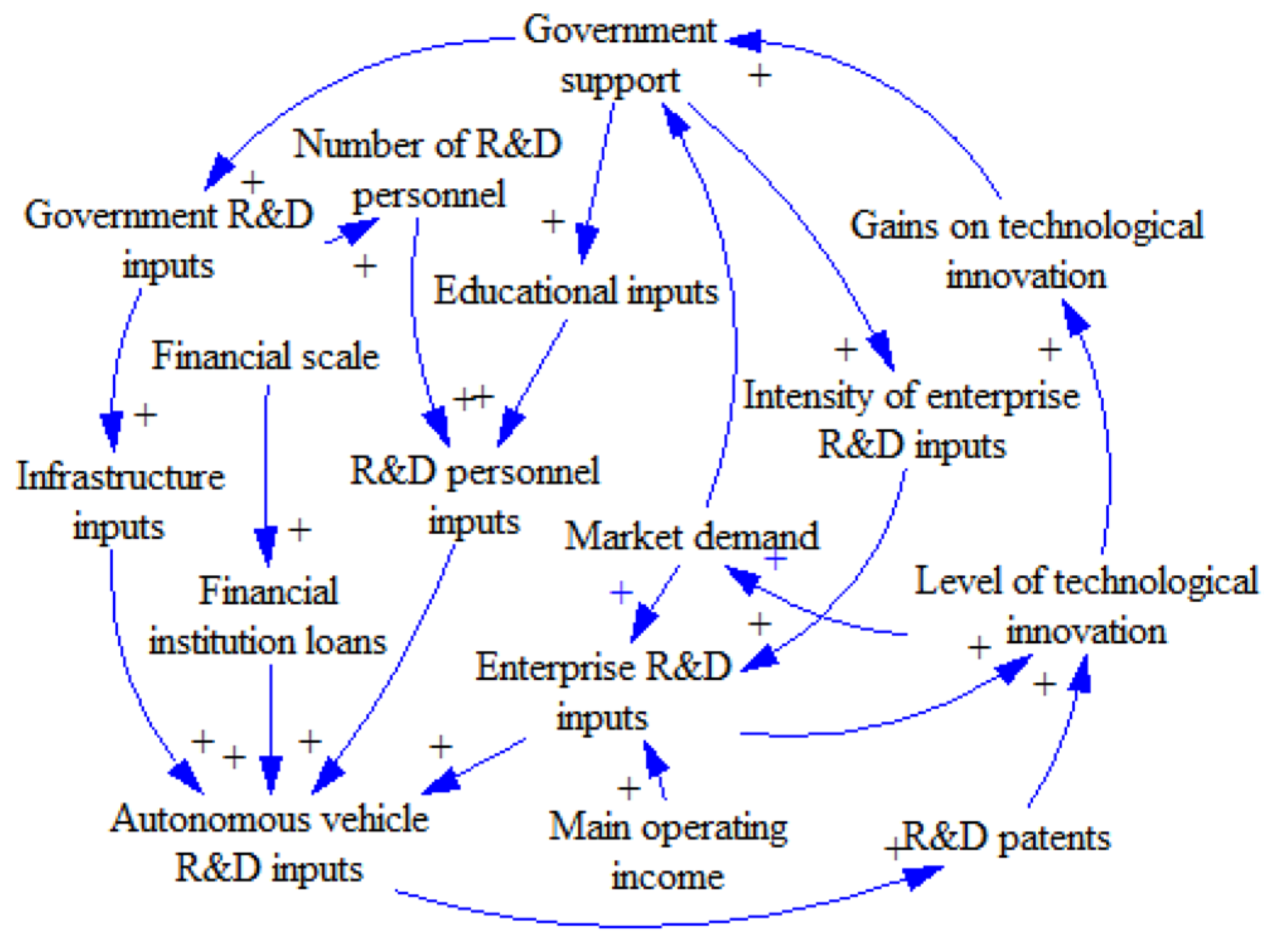
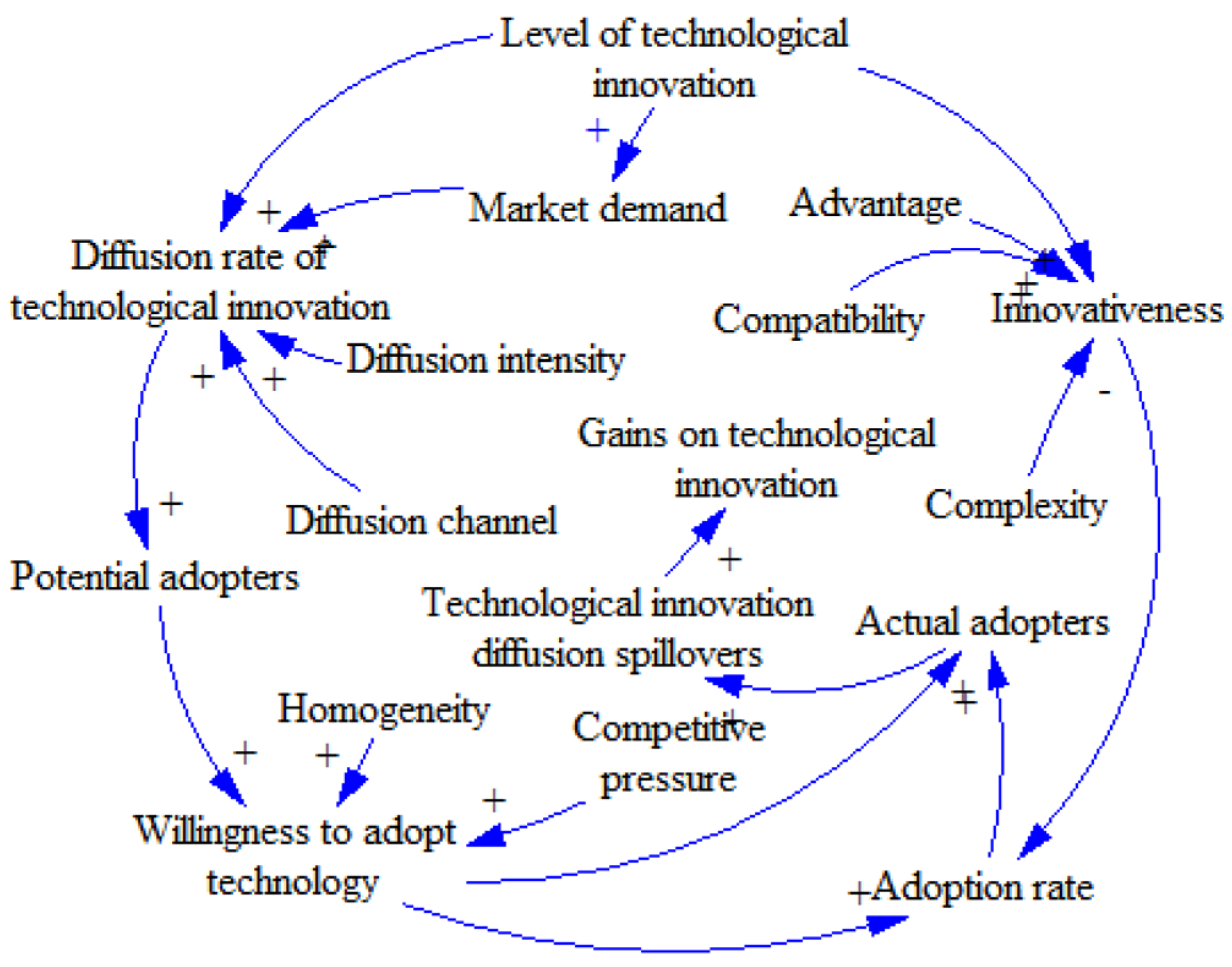
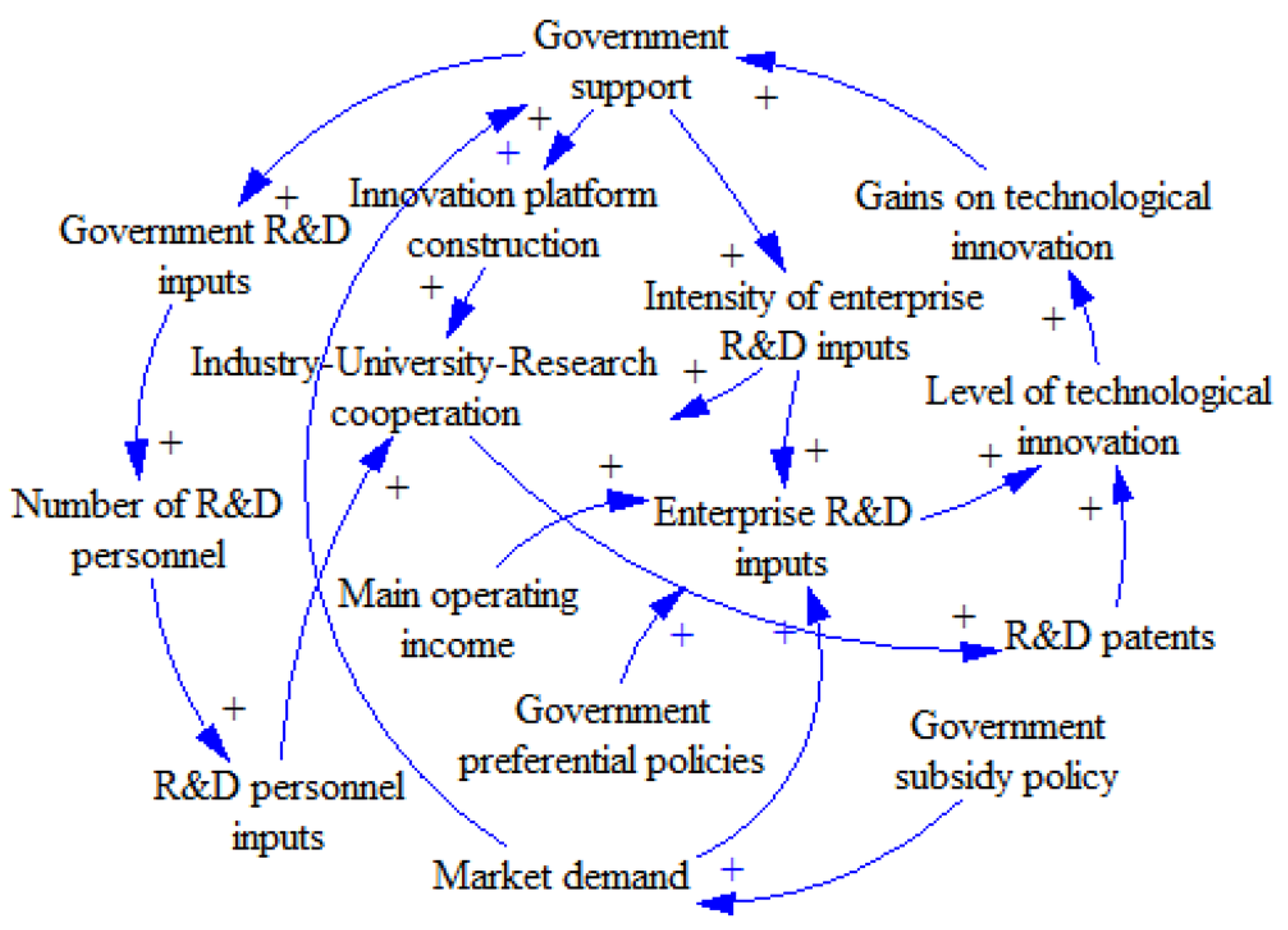
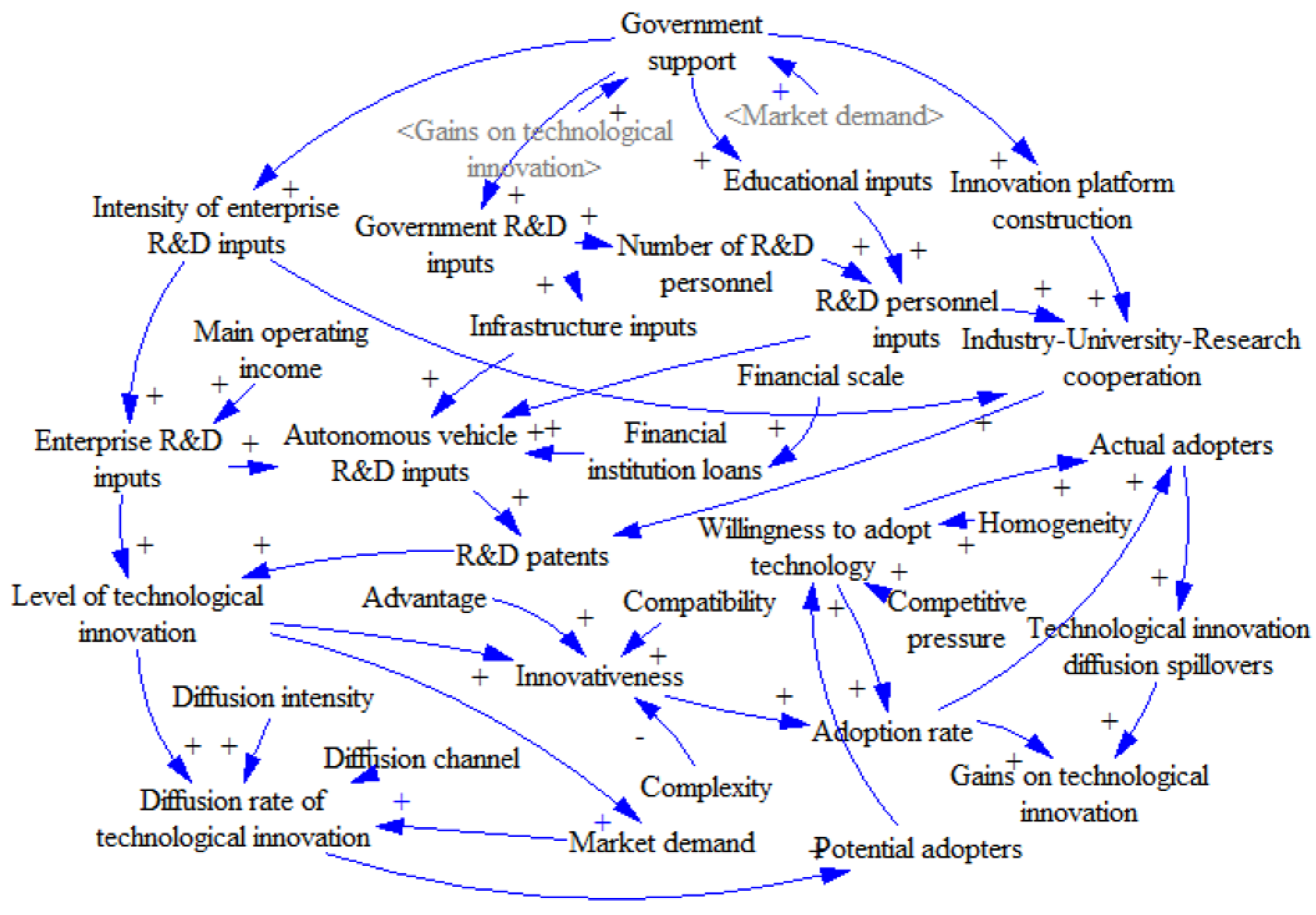
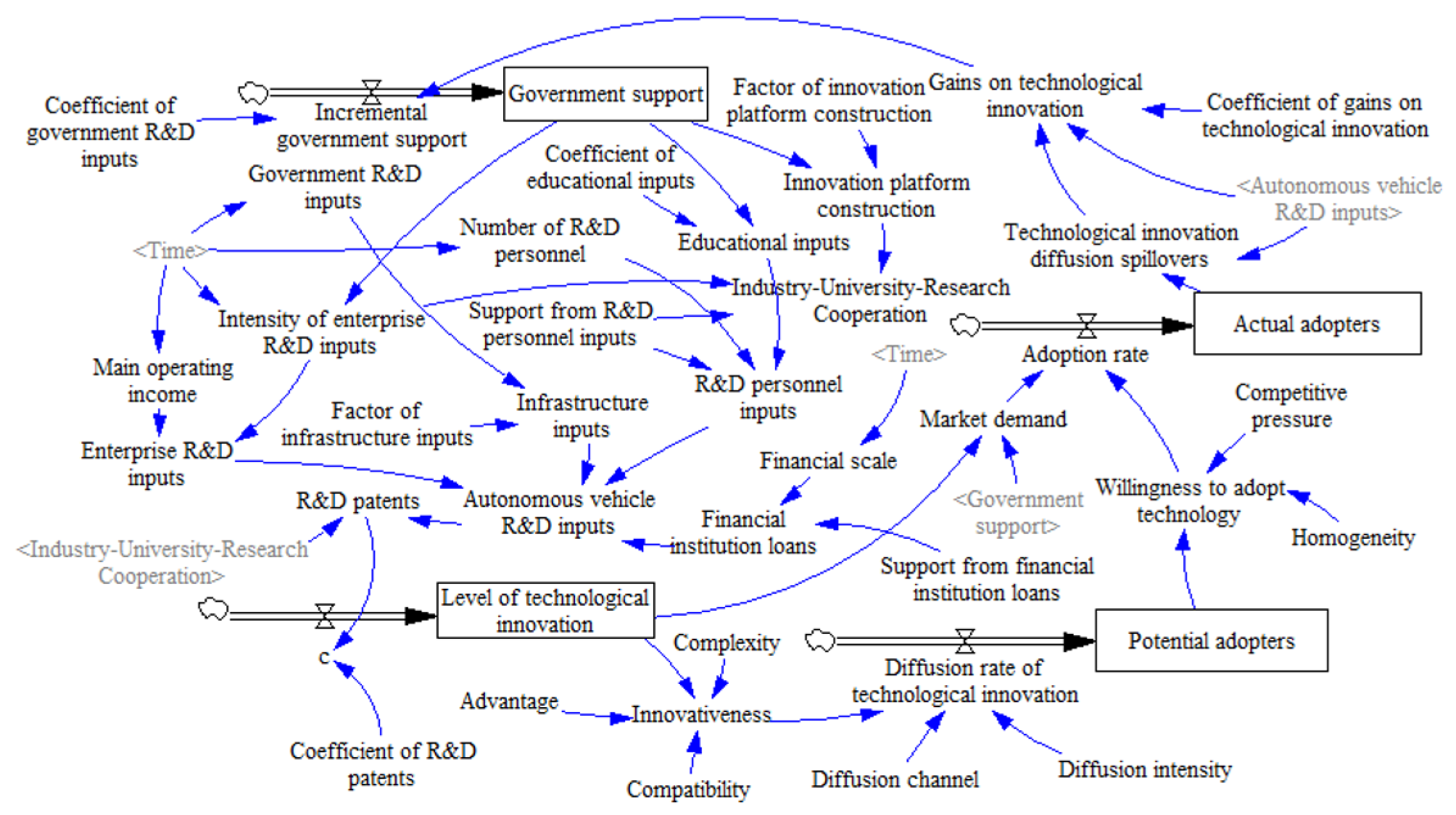




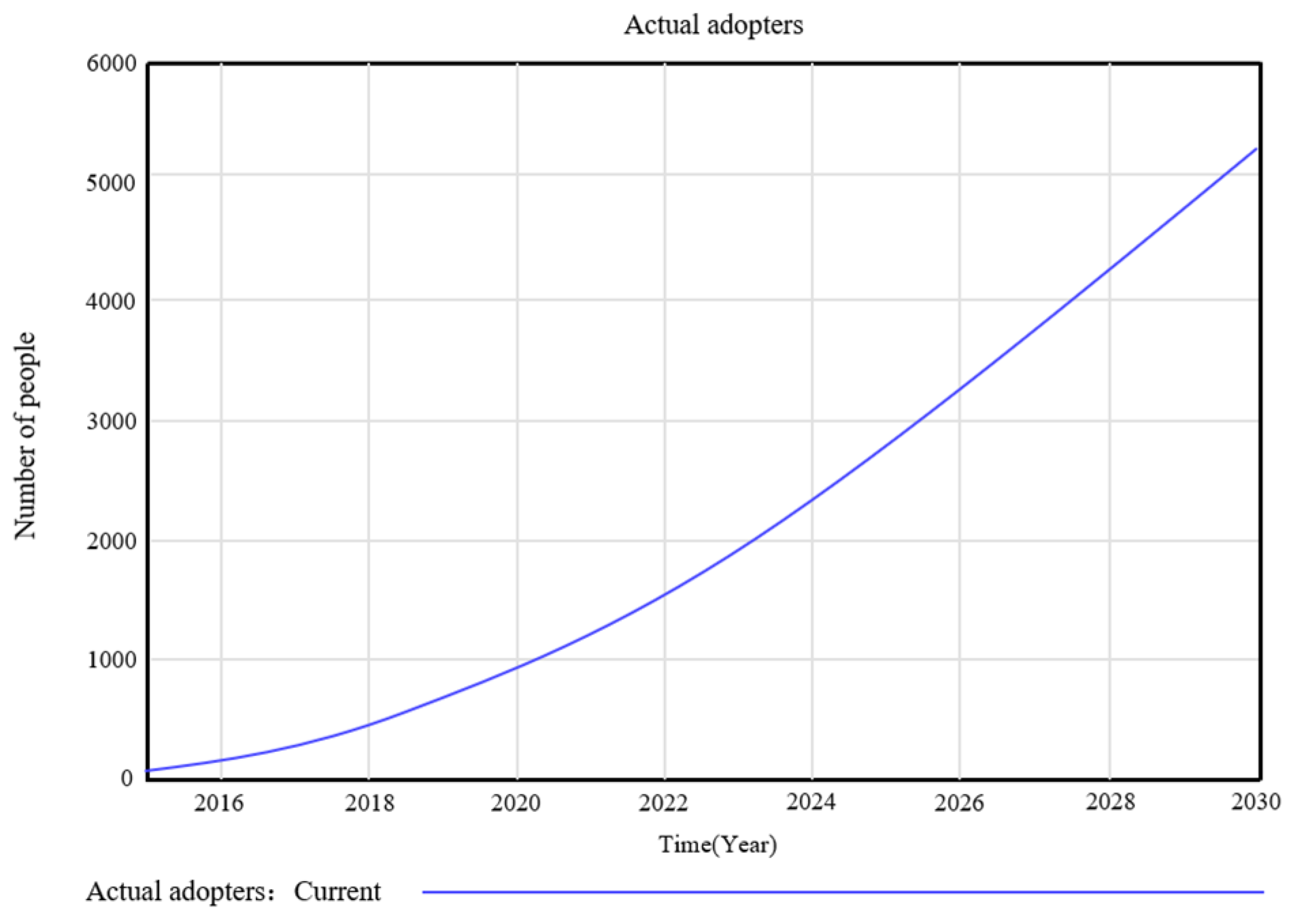


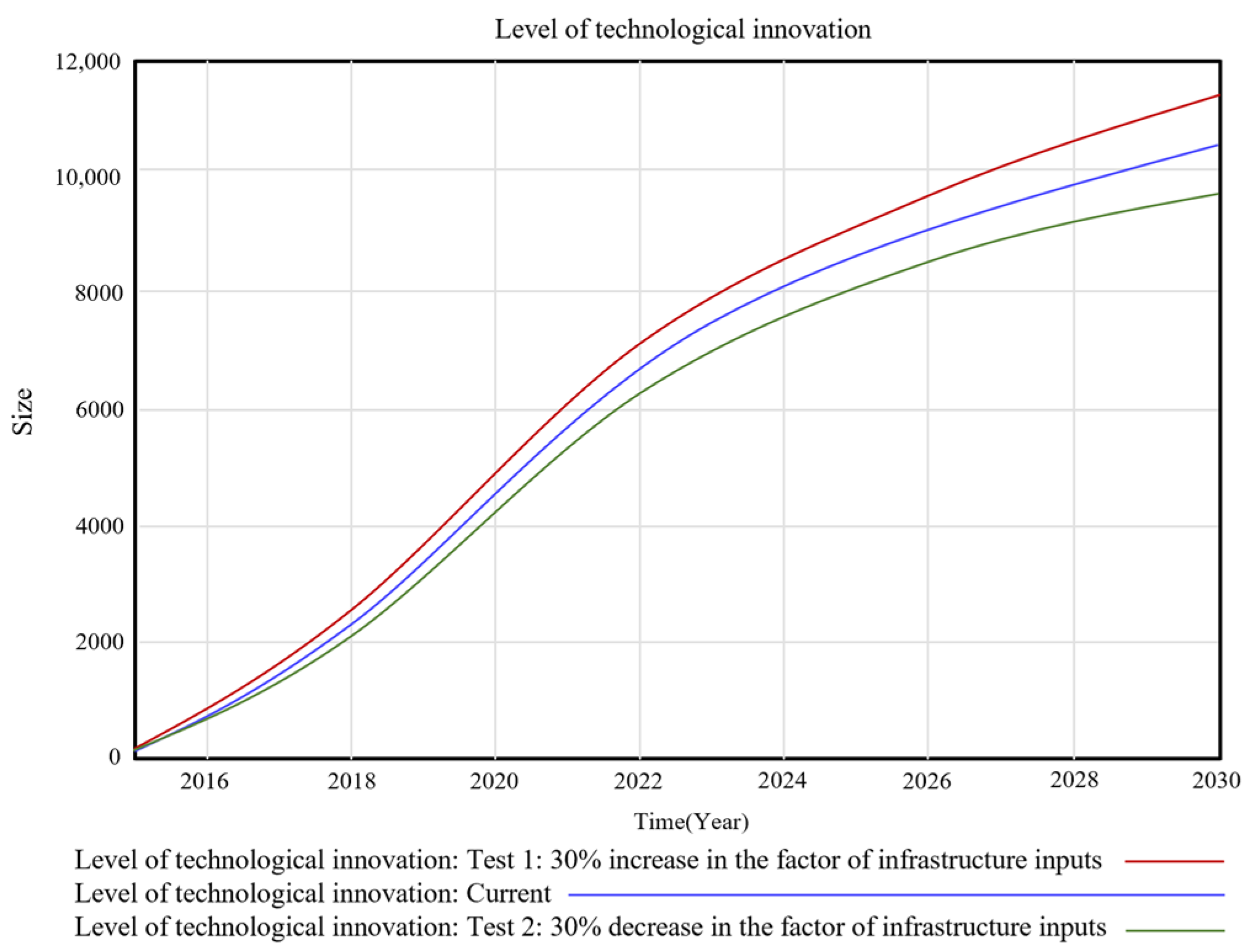

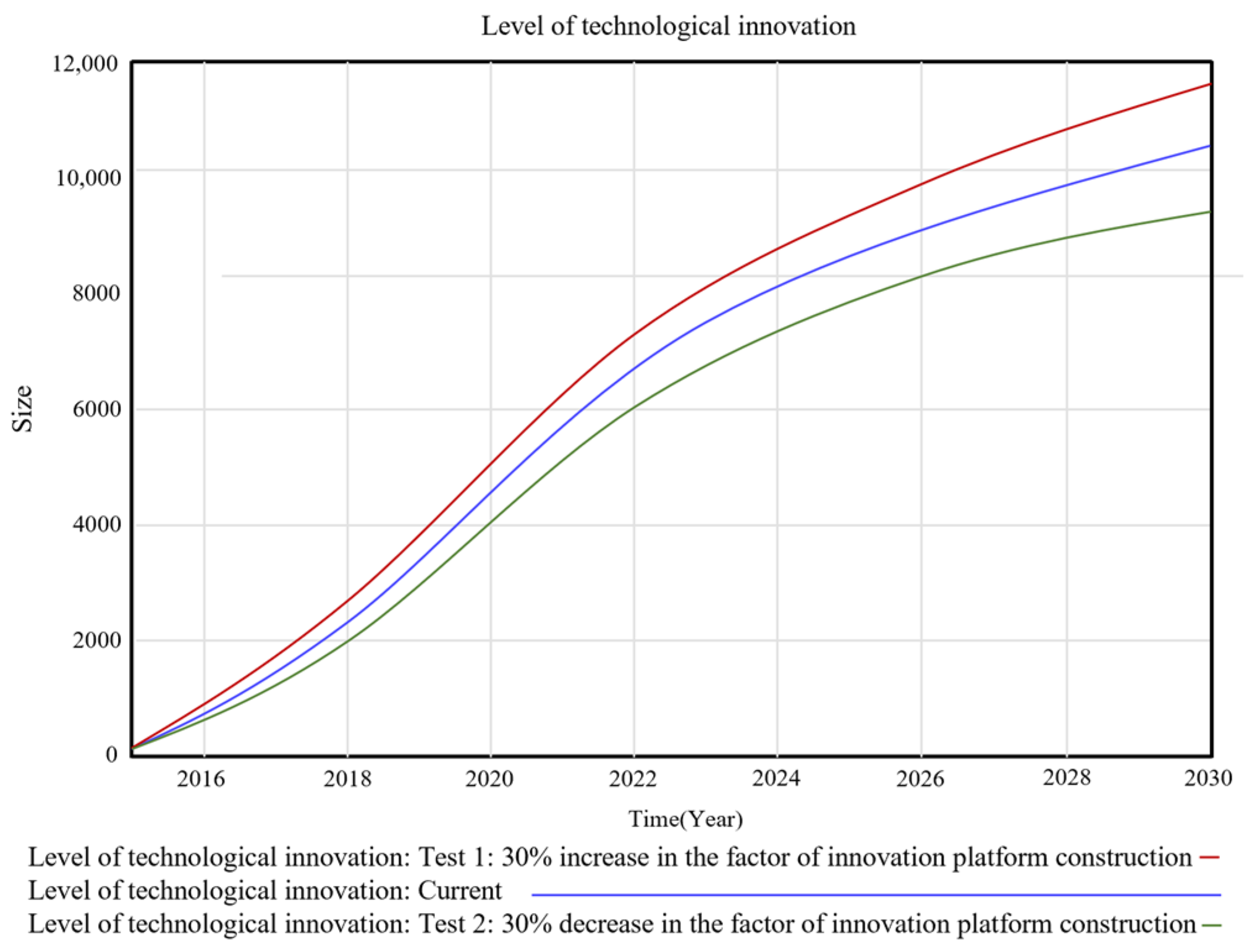
| Year | Government Support | Level of Technological Innovation | ||||
|---|---|---|---|---|---|---|
| Simulated Value | Actual Value | Error Rates | Simulated Value | Actual Value | Error Rates | |
| 2015 | 2488.45 | 2630.24 | 5.39% | 346 | 378 | 8.47% |
| 2016 | 2557.34 | 2695.17 | 5.11% | 829 | 811 | −2.22% |
| 2017 | 2640.62 | 2744.83 | 3.80% | 1350 | 1491 | 9.46% |
| 2018 | 2736.82 | 2902.60 | 5.71% | 2273 | 2454 | 7.38% |
| 2019 | 2826.41 | 2986.35 | 5.36% | 3528 | 3741 | 5.69% |
| 2020 | 2910.77 | 3072.96 | 5.28% | 4695 | 4911 | 4.40% |
| 2021 | 2884.05 | 2913.07 | 1.00% | 5806 | 5784 | −0.38% |
| 2022 | 3094.13 | 3058.28 | −1.17% | 7042 | 7513 | 6.27% |
| 2023 | 3159.35 | 3147.63 | −0.37% | 7834 | 7648 | −2.43% |
| Variables | Current | Test 1 | Test 2 |
|---|---|---|---|
| Complexity | 0.254 | 0.203 | 0.305 |
| Compatibility | 0.368 | 0.442 | 0.294 |
| Advantage | 0.421 | 0.505 | 0.337 |
| Innovativeness | 0.535 | 0.744 | 0.326 |
Disclaimer/Publisher’s Note: The statements, opinions and data contained in all publications are solely those of the individual author(s) and contributor(s) and not of MDPI and/or the editor(s). MDPI and/or the editor(s) disclaim responsibility for any injury to people or property resulting from any ideas, methods, instructions or products referred to in the content. |
© 2025 by the authors. Licensee MDPI, Basel, Switzerland. This article is an open access article distributed under the terms and conditions of the Creative Commons Attribution (CC BY) license (https://creativecommons.org/licenses/by/4.0/).
Share and Cite
Feng, R.; Liu, Y.; Li, M.; Zhou, F. Research on Autonomous Vehicle Technology Innovation Ecosystem in China Based on System Dynamics. Systems 2025, 13, 269. https://doi.org/10.3390/systems13040269
Feng R, Liu Y, Li M, Zhou F. Research on Autonomous Vehicle Technology Innovation Ecosystem in China Based on System Dynamics. Systems. 2025; 13(4):269. https://doi.org/10.3390/systems13040269
Chicago/Turabian StyleFeng, Ruiyu, Yingqi Liu, Mu Li, and Fei Zhou. 2025. "Research on Autonomous Vehicle Technology Innovation Ecosystem in China Based on System Dynamics" Systems 13, no. 4: 269. https://doi.org/10.3390/systems13040269
APA StyleFeng, R., Liu, Y., Li, M., & Zhou, F. (2025). Research on Autonomous Vehicle Technology Innovation Ecosystem in China Based on System Dynamics. Systems, 13(4), 269. https://doi.org/10.3390/systems13040269





